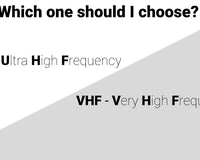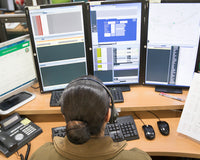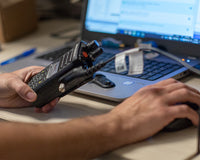Updated April 12, 2023
The need for instant communication is no stranger to school administrators. Two way radios have long been used for directing traffic, connecting administrators with staff and faculty, keeping off-campus activity on-track, and much more. Sadly, there has been another dire need for instant communication steadily growing in our communities.
That need is for school security. In recent years violence in our school systems has sky-rocketed to levels unfathomable just decades ago. Walkie talkies can provide your school’s team with an invaluable tool that will undoubtedly help to create a safer school environment for your kids. That tool? A two-way radio offering instant communication. As with the proverb, “Knowledge is power,” when you empower your team with instant updates to a situation, that knowledge better prepares them for keeping the situation in control and your students safe.
This article will go over some key differences in relying on two way radios over cell phones for your team, and will provide a list of handheld and mobile two way radio options to fit any school budget. For the latest pricing on any two way radio model listed, follow the link provided and add it to your cart. You’re also always welcome to call us at (888) 733-7681 or fill out our contact-us form and one of our certified master radio consultants would be happy to help.
Walkie Talkies vs Cell Phones
Every school has a budget, so you are right in questioning why you should invest in two way radios for your staff instead of simply relying on the cell phones you know most team members already own. You may want to consider the benefits of walkie talkies in your teams’ hands over cell phones before making your decision.
The day-to-day on school campuses has become more and more unpredictable. Cell phones allow for more variables into your communication equation than schools can sometimes afford. With possible unreliable coverage, and user error, crucial messages could be lost at critical times when every second that passes could threaten the safety of students.
Two way radios can be set up so they are extremely user friendly, and need only be turned on for your messages to be relayed. Also, walkie talkies can relay your message to every unit in your fleet, so you can guarantee the closest faculty member to an arising situation will be there in time.
Something to reiterate is the two way radio’s ability to communicate to multiple team members with ease. A standard cell phone call will only reach one end-user at a time, and you would never want to leave a situation up to the chance of a group text being seen in time. Walkie talkies provide your staff instant messaging capabilities to anyone on the channel, leaving out the guess work of having to decide who to call first if a security issue arises on your campus.
Our recommendation? Give each one of your faculty and staff members the support they need by providing your teams with walkie-talkies instead of relying on cell phones.
Renting Two Way Radios
If you’re worried about the initial investment of radios without knowing for sure if they are a good fit, we also offer a radio rental program with our CP200D radios, listed below. This program allows you a “trial run” with a world class communication product. This way you can see the benefits firsthand without having to commit to a whole fleet of radios before knowing what’s best for your school. If the rental program interests you, please call us at (888) 733-7681 or fill out our contact-us form for more information.
Best Handheld Walkie Talkies for Schools
As with most things in life, there is not a single solution for a school’s communication needs. The type of two way radio needed will vary based on the use you intend it for. The only thing I would definitively recommend is that you land on a radio with multiple channel capability. This will ensure you are able to tailor communication between teams to those who need to hear each message.
You may be wondering, “If there are teams on different channels, how could all members be notified in an emergency situation?” Radios make that easy for you, there is a programmable scanning function that can be set so that every radio will hear a message sent via any given parameters. One way is to program the fleet to have a designated emergency channel that is always broadcast across all channels, and if you would like one of our team members would be happy to talk you through all the options available to you.
Making use of the tailored communication provided by walkie talkies is just one way radios will prove priceless in the efficiency of how information will flow at your institution. You are also able to design the makeup of your radio fleet, choosing how many of each radio type to incorporate. This allows you to customize the fleet to the communication needs your individual school or an entire school district. The 2-3 watt Motorola SL300, with no display, could be adequate for directing traffic, while you may find the more rugged and powerful Motorola CP200D, with 4-5 watts and an IP54 rating, to be more suitable for maintenance staff. The budget friendly RCA RDR2500 and RDR2550 allow you to take advantage of new digital technology while still allowing communication with your existing analog equipment.
Something to always keep in mind is how powerful your radios may need to be and in which frequency spectrum (UHF or VHF) are they making use of. Take the example above. Your staff member who is directing traffic outside may not need the power to get their messages to others such as a maintenance member who may be deep in the school at any moment. This is due to the fact most modern schools are constructed with thick concrete walls with steel reinforced concrete which makes it difficult for a weaker radio signal to properly navigate the school grounds.
With regards to the frequency spectrum, with a choice between ultra-high frequency (UHF) and very-high frequency (VHF), generally speaking you will want to always lean toward radios operating in the UHF spectrum. This is because UHF frequencies are higher than VHF allowing UHF signals to more easily penetrate through thick concrete walls. Also, the UHF spectrum is typically better for more urban locales which schools tend to be in. For more details as to why you should choose UHF or VHF two way radios, check out this article where we outline key pros and cons to each frequency spectrum.
I have also added mobile radios below that we feel are great for school administrations to make use of in furthering their communication ability and range. Mobile radios can be put in buses or other school vehicles that travel off campus for any reason, as well as be made into a command station in the main office for efficient coordination. Just like with portable radios, look for one that fits both your power needs and has an appealing device configuration to ensure you are happy with your choice.
As always feel free to contact us at any point to discuss your communication needs and which two way radios could be of most use to you.
Motorola Two Way Radios for Schools
Motorola CP185 |
Motorola CP100D |
 |
 |
| Shop the CP185 | Shop the CP100D |
|
|
Motorola CP200D |
Motorola DTR700 |
 |
 |
| Shop the CP200D | Shop the DTR700 |
|
|
Motorola SL300 |
Motorola SL3500e |
 |
 |
| Shop the SL300 | Shop the SL3500e |
|
|
ICOM Two Way Radios for Schools
Icom F3001/F4001 |
 |
| Shop the F3001/F4001 |
|
Best Mobile Two Way Radios for Schools
Motorola Mobile Radios for Schools
Motorola CM200D |
Motorola CM300D |
 |
 |
| Shop the CM200D | Shop the CM300D |
|
|
Icom Mobile Radios for Schools
Icom F5021/F6021 |
 |
| Shop the F5021/F6021 |
|
Wrap it up
At the risk of repeating myself, there is no single solution for a school's communication needs. The solution for you may not even be one of the radio models represented above. That is perfectly OK, don't get disheartened if you aren't seeing quite the right fit for your school. RadioDepot is here for people exactly like you. That is why we choose to write these articles in the first place. We hope that we gave you a good starting point on your journey to create the best communication platform for your school.
If you have any questions not covered here, or have further thoughts about something I went over, you have a few options. You can leave a comment below, email sales@radiodepot.com directly, call us at (888) 733-7611, or fill out our contact-us form and one our our master radio consultants will talk you through all your needs.
As always, if you found this article helpful, share the wealth of knowledge with your friends and family on social! You never know who you could be helping.






